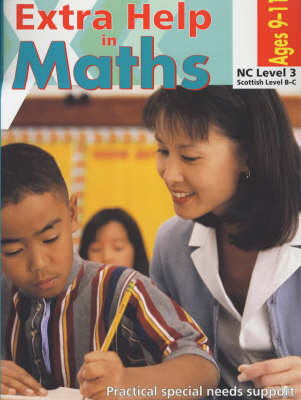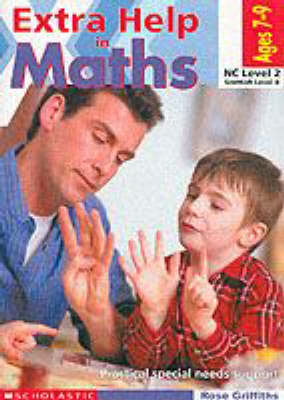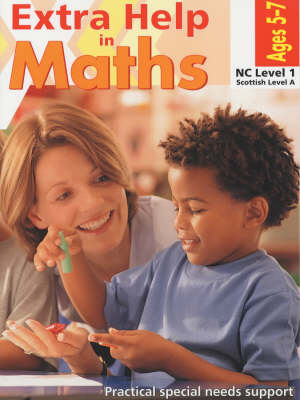Extra Help in Maths S.
3 total works
'Special needs' encompasses a very broad spectrum of difficulties in the primary classroom, from lower than expected achievement to clinically identified disabilities. We all find some aspects of learning harder than others. However, it is universally true that some approaches to learning suit each of us better than others. Some teaching helps us to make sense confusing concepts, other approaches just 'mudy the waters'. When learning is particularly hard work anyway, having a variety of approaches available is key to unlocking understanding and encouraging children to stay on task. This visually appealing series of three books (for children at NC Level 1/Scottish Level A aged 5-7; NC Level 2/Scottish Level B aged 7-9; NC Level 3/Scottish Level B-C aged 9-11) will suggest a wide range of kinaesthetic and visual resources and activities through which teachers and learning support assistants in the classroom, or parents at home, can offer alternative learning experiences when more worksheets are clearly not a solution. The books will be full of colourful photographs of things to make and do with the children, to grab their attention and give them ownership of their work.
Showing objects and games made by a teacher and children should show that these ideas are well within the grasp of and parent or teacher. Throughout the books, the activities are linked to simple explanations of the relevant maths and the difficulties commonly associated with acquiring and understanding of it; for example, counting to 10 in the Level 1 book and developing addition strategies in the NC Level 2 book. This series addresses the market opportunity for a 'dip in' resource. that offers a range of alternatives to yet more worksheet activities and counting plastic cubes.
Showing objects and games made by a teacher and children should show that these ideas are well within the grasp of and parent or teacher. Throughout the books, the activities are linked to simple explanations of the relevant maths and the difficulties commonly associated with acquiring and understanding of it; for example, counting to 10 in the Level 1 book and developing addition strategies in the NC Level 2 book. This series addresses the market opportunity for a 'dip in' resource. that offers a range of alternatives to yet more worksheet activities and counting plastic cubes.
'Special needs' encompasses a very broad spectrum of difficulties in the primary classroom. from lower than expected achievement to clinically identified disabilities. We all find some aspects of learning harder than others. However, it is universally true that some approaches to learning suit each of us better than others. Some teaching helps us to make sense confusing concepts, other approaches just 'muddy the waters'. When learning is particularly hard work anyway, having a variety of approaches available is key to unlocking understanding and encouraging children to stay on task. This visually appealing series of three books (for children at NC Level 1/Scottish Level A ages 5-7; NC Level 2/Scottish Level B aged 7-9; NC Level 3/Scottish Level B-C aged 9-11) will suggest a wide range of kinaesthetic and visual resources and activities through which teachers and learning support assistants in the classroom, or parents at home, can offer alternative learning experiences when more worksheets are clearly not a solution. The books will be full of colourful photographs of things to make and do with the children, to grab their attention and give them ownership of their work.
Showing objects and games made by a teacher and children should show that these ideas are well within the grasp of and parent or teacher. Throughout the books, the activities are linked to simple explanations of the relevant maths and the difficulties commonly associated with acquiring and uinderstanding of it; for example, counting to 10 in the Level 1 book and developing addition stategies in the NC Level 2 book. This series, addresses the market opportunity for a 'dip in' resource, that offers a range of alternatives to yet more worksheet activities and counting plastic cubes.
Showing objects and games made by a teacher and children should show that these ideas are well within the grasp of and parent or teacher. Throughout the books, the activities are linked to simple explanations of the relevant maths and the difficulties commonly associated with acquiring and uinderstanding of it; for example, counting to 10 in the Level 1 book and developing addition stategies in the NC Level 2 book. This series, addresses the market opportunity for a 'dip in' resource, that offers a range of alternatives to yet more worksheet activities and counting plastic cubes.
'Special needs' encompasses a very broad spectrum of difficultiesin the primary classroom, from lower than expected achievements to clinically identified disabilities. We all find some aspects of learning harder than others, However,it is universally true that some approaches to learning suit each of us better than others. Some teaching helps us to make sense of confusing concepts, other approaches just 'muddy the waters'. When learning is particularly hard work anyway, having a variety of approaches available is key to unlocking understanding and encouraging children to stay on task. This visually appealing series of three books (for children at NC Level 1/Scottish Level A aged 5-7; NC Level 2/Scottish Level B aged 7-9; NC Level 3/Scottish Level B-C aged 9-11) will suggest a wide range of kinaesthetic and visual resources and activities through which teachers and learning support assistants in the classroom, or parents at home, can offer alternative learning experiences when more worksheets are clearly not a solution. The books will be full of colourful photographs of things to make and do with the children, to grab their attention and give them ownership of their work.
Showing objects and games made by a teacher and children should show that these ideas are well within the grasp of and parent or teacher. Throughout the books, the activities are linked to simple explanaations of the relevant maths and the difficulties commonly associated with acquiring an understanding of it; for example, counting to 10 in the Level 1 book and developing addition strategies in the NC Level 2 book. This series addresses the market opportunity for a 'dip in' resource, that offers a range of alternatives to yet more worksheets activities and counting plastic cubes.
Showing objects and games made by a teacher and children should show that these ideas are well within the grasp of and parent or teacher. Throughout the books, the activities are linked to simple explanaations of the relevant maths and the difficulties commonly associated with acquiring an understanding of it; for example, counting to 10 in the Level 1 book and developing addition strategies in the NC Level 2 book. This series addresses the market opportunity for a 'dip in' resource, that offers a range of alternatives to yet more worksheets activities and counting plastic cubes.


